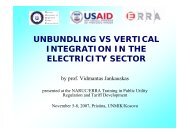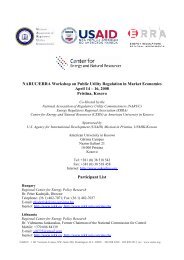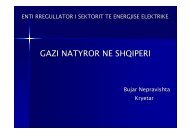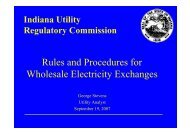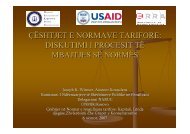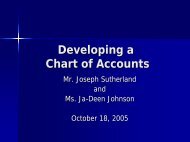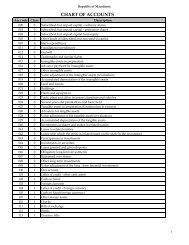Calculating the Revenue Requirement in Electricity
Calculating the Revenue Requirement in Electricity
Calculating the Revenue Requirement in Electricity
You also want an ePaper? Increase the reach of your titles
YUMPU automatically turns print PDFs into web optimized ePapers that Google loves.
<strong>Calculat<strong>in</strong>g</strong> <strong>the</strong> <strong>Revenue</strong><strong>Requirement</strong> <strong>in</strong> <strong>Electricity</strong>Presentation toEnergy Regulatory Agencyof <strong>the</strong> Republic of SerbiaByEr<strong>in</strong> Laudenslager, CPA
<strong>Revenue</strong> <strong>Requirement</strong>s• The annual revenues required by <strong>the</strong>firm to cover both its expenses and have<strong>the</strong> opportunity to earn a fair rate ofreturn.• The annual costs to provide safe andreliable service to <strong>the</strong> company’scustomers that <strong>the</strong> company is allowedto recover through rates.1
<strong>Revenue</strong> <strong>Requirement</strong> Formula• Required <strong>Revenue</strong>s = Expenses +(Rate Base x Rate of Return)• Rate Base• Investment <strong>in</strong> facilities, equipment ando<strong>the</strong>r equipment used to provide service• Rate of Return• The return earned, or allowed to be earned,on <strong>the</strong> utilities rate base2
<strong>Revenue</strong> <strong>Requirement</strong> Formula• Expenses• Operat<strong>in</strong>g Expenses• Operation and Ma<strong>in</strong>tenance• Adm<strong>in</strong>istrative and General• Must determ<strong>in</strong>e whe<strong>the</strong>r to allow ordisallow expense for rate-mak<strong>in</strong>gpurposes3
Rate of Return• Compensation to <strong>in</strong>vestors for <strong>the</strong>ir<strong>in</strong>vestment• A percentage applied rate base• To be recovered <strong>in</strong> rates• Generally two types of cost associated withROR – Cost of Capital• Debt Capital• Equity Capital• ROR = Weighted cost of capital4
Debt Capital• Long term and short term debt• Example$60 debt x 8% <strong>in</strong>terest rate(60 x 8% = $4.80)Cost of debt = $4.805
Equity Capital• Common stock and reta<strong>in</strong>ed earn<strong>in</strong>gs• Example$40 equity x 10% <strong>in</strong>terest rate(40 x 10% = $4.00)Cost of equity = $4.006
Rate of ReturnInvestment Cost Rate CostDebt $60 8% $4.80Equity $40 10% $4.00$100 $8.80Weighted Cost of Capital$8.80/ $100 = 8.8%Rate of Return = 8.8%7
Discounted Cash Flows• An <strong>in</strong>vestors’ expected return on anequity <strong>in</strong>vestment take two forms:• Dividends• Growth <strong>in</strong> stock prices8
Cost of Capital• Debt Capital• Contractual Return (Interest)• Equity Capital• Noncontractual Return (Dividends & Growth)• Riskier than Debt, <strong>the</strong>refore, higher cost to<strong>in</strong>duce <strong>in</strong>vestors9
Return on EquityDividend = $4.00 per share of stockStock Price = $100.00 per share of stockDividend Yield = ($4.00/$100.00) 4%+Expected Growth <strong>in</strong> Investment = 6%Total expected return = 10%10
Assess<strong>in</strong>g Value of Utility – Rate Base• Rate Base Determ<strong>in</strong>ationGross Plant <strong>in</strong> Service (orig<strong>in</strong>al cost of physical asset)Less : Accumulated DepreciationEquals : Net Plant <strong>in</strong> ServicePlus : Work<strong>in</strong>g CapitalPlus : Materials and suppliesPlus : Customer depositsLess : Cumulative reserve for deferred <strong>in</strong>come taxesEquals : Rate Base11




